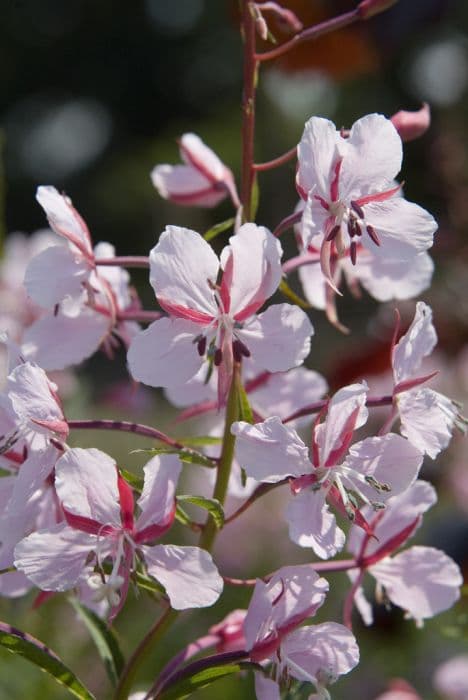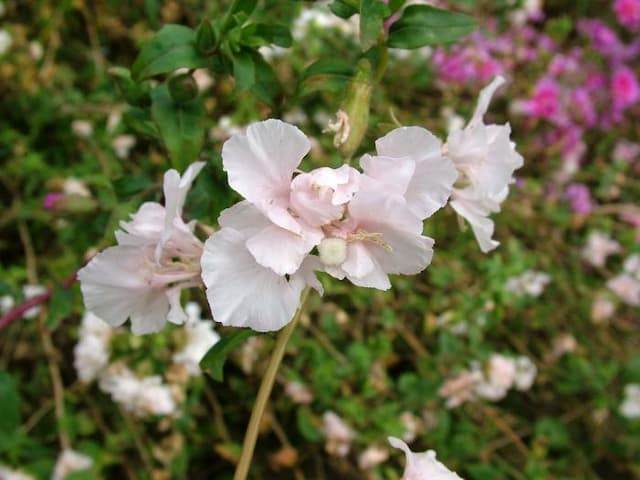Fuchsia Fuchsia 'Lillian Annetts' (d)

ABOUT
Fuchsia 'Lillian Annetts' is a beautiful flowering plant renowned for its striking appearance. The most captivating feature of this cultivar is its exquisite flowers. Each flower is a stunning display of vibrant colors, with deep pink to purple petals that elegantly droop down, creating a delicate teardrop shape. The petals surround a softer, paler inner set that may appear almost lavender to white, cradling a cluster of long, slender stamens that often protrude gracefully from the center. This creates a delightful contrast in both color and texture. The blooms hang from the branches like dainty earrings, giving the plant an elegant and sophisticated look. The foliage of 'Lillian Annetts' complements its floral display with deep green leaves that have a subtle glossy finish and are slightly elongated with a gentle serration on the margins, adding to the overall lushness of the plant. These flowers typically appear in profusion, creating a spectacular sight when the plant is in full bloom. These characteristics make Fuchsia 'Lillian Annetts' a popular choice for gardeners and plant enthusiasts who wish to add a touch of grace and vivid color to their garden palette.
About this plant
 Names
NamesFamily
Onagraceae
Synonyms
Lady's Eardrops, Fuchsia
Common names
Fuchsia 'Lillian Annetts'
 Toxicity
ToxicityTo humans
Fuchsias, including the Fuchsia 'Lillian Annetts', are generally considered non-toxic to humans. However, consuming any non-food plant can potentially cause mild digestive discomfort. If someone has a specific allergy to the plant, more severe reactions may occur, but for the general population, fuchsias pose minimal risk when touched or ingested in small quantities.
To pets
Fuchsias are also considered non-toxic to pets. If a pet, such as a dog or cat, ingests parts of a Fuchsia plant, they are unlikely to experience anything more severe than possible mild gastrointestinal upset. Always monitor your pets to ensure they do not eat large amounts of any plant, as it could cause stomach distress or an intestinal blockage, regardless of the plant's toxicity level.
 Characteristics
CharacteristicsLife cycle
Perennials
Foliage type
Deciduous
Color of leaves
Green
Flower color
Pink
Height
1-2 feet (30-61 cm)
Spread
1-2 feet (30-61 cm)
Plant type
Shrub
Hardiness zones
9
Native area
Central America
Benefits
 General Benefits
General Benefits- Enhances Garden Aesthetics: The Fuchsia 'Lillian Annetts', commonly known as fuchsia, adds vibrant color and visual interest to gardens with its distinctive pendant-shaped flowers.
- Attracts Pollinators: Fuchsias are known for attracting hummingbirds, bees, and butterflies, which are essential for pollinating the garden.
- Versatile Planting Options: This plant is versatile in landscaping, suitable for hanging baskets, containers, or as a border plant, providing flexibility in garden design.
- Shade Tolerance: Fuchsias thrive in partial shade, making them an excellent choice for garden areas that do not receive full sunlight.
- Long Blooming Period: Fuchsia plants have a long flowering season, often from spring through fall, providing a sustained display of beauty.
- Easy to Propagate: Fuchsias can be easily propagated from cuttings, allowing gardeners to expand their collection without additional cost.
- Relatively Low Maintenance: With basic care, like regular watering and occasional feeding, fuchsias can grow well and remain healthy.
 Medical Properties
Medical PropertiesThis plant is not used for medical purposes.
 Air-purifying Qualities
Air-purifying QualitiesThis plant is not specifically known for air purifying qualities.
 Other Uses
Other Uses- As a natural dye: The vibrant flowers of the Fuchsia can be used to create a pink-purple dye for fabrics or inks.
- In landscape design: Fuchsia can be incorporated into fairy gardens or miniature landscapes due to its delicate and ornamental appearance.
- For culinary decoration: The flowers of Fuchsia can be used to add a splash of color to salads or as an edible garnish on desserts and cocktails.
- As a photography subject: Fuchsia, with its striking flowers, is a popular choice for botanical photographers and artists looking to capture its unique beauty.
- In crafting: The flowers and foliage can be used in floral crafts, such as making pressed flower bookmarks or cards.
- As a teaching tool: Fuchsia plants can be used in educational settings to teach about plant biology, pollination, and hybridization techniques.
- In bonsai culture: Some cultivators may use Fuchsia as a bonsai plant, training its branches into artistic shapes over time.
- As living jewelry: Creative jewelry makers sometimes use small Fuchsia flowers in terrarium pendants or resin bangles.
- In container gardening: Fuchsia plants are well suited for hanging baskets and container gardening, adding vertical interest to patios and balconies.
- For color theming events: Fuchsia flowers can be used in event decorations when there’s a specific color theme, such as pink or purple, for weddings or parties.
Interesting Facts
 Feng Shui
Feng ShuiThe Fuchsia is not used in Feng Shui practice.
 Zodiac Sign Compitability
Zodiac Sign CompitabilityThe Fuchsia is not used in astrology practice.
 Plant Symbolism
Plant Symbolism- Grace: Fuchsia flowers are known for their elegant drooping blossoms, which often symbolize grace and finesse due to their delicate appearance.
- Good taste: Because of their unique and attractive colors, fuchsias can represent good taste and a sense of refinement.
- Confiding love: Historically, fuchsia flowers were given as a symbol of confiding love, entrusting the receiver with the giver's feelings.
- Ardent affection: The vibrant hues and the way fuchsia blossoms hang like lanterns have also been seen as a sign of deep and passionate affection.
 Water
WaterLady's eardrops should be watered regularly to maintain moist but not waterlogged soil, especially during the growing season. Typically, this would be about 1 to 2 times per week, but you must adjust for climate, weather, and soil type. It is best to check the top inch of soil for dryness and water thoroughly until excess water drains out of the bottom of the pot. The amount needed will depend on the pot size, but generally, a half to one gallon per week should suffice for a standard hanging basket.
 Light
LightLady's eardrops thrive in bright, indirect light. They should be placed in a spot where they receive morning sunlight and shade during the harsh afternoon rays. An east-facing window or a dappled shade area in the garden is ideal. Avoid direct midday sun, which can scorch the delicate leaves and flowers.
 Temperature
TemperatureLady's eardrops prefer cooler temperatures and flourish best when daytime temperatures are between 60 to 75 degrees Fahrenheit and nighttime temperatures don't drop below 50 degrees Fahrenheit. They can survive as low as 40 degrees Fahrenheit, but frost is detrimental. Consistently warm temperatures above 80 degrees Fahrenheit may stress the plant and hinder blooming.
 Pruning
PruningPruning lady's eardrops is important to promote bushy growth and abundant flower production. Pinch or cut back the tips of the stems in early spring to encourage branching. After the first flush of flowers, prune by one-third to stimulate a second blooming period. Regular deadheading of spent flowers during the season will also enhance further blooming.
 Cleaning
CleaningAs needed
 Soil
SoilFor Fuchsia 'Lillian Annetts', use a well-draining potting mix with peat moss and perlite or sand; maintain soil pH between 6.0-7.0 for optimal growth.
 Repotting
RepottingFuchsia 'Lillian Annetts' should be repotted annually or when it outgrows its current pot, typically during spring or early summer.
 Humidity & Misting
Humidity & MistingFuchsia 'Lillian Annetts' thrives best in high humidity conditions, ideally around 60-70%.
 Suitable locations
Suitable locationsIndoor
Keep in bright, indirect light and high humidity.
Outdoor
Place in dappled shade, protect from strong winds.
Hardiness zone
9-11 USDA
 Life cycle
Life cycleFuchsia 'Lillian Annetts' starts its life as a seed, which, when sown in a warm and moist environment, germinates to grow into a seedling. These young plants require careful attention to light and water, and once they are strong enough, they are transplanted to a larger pot or a garden setting. As the fuchsia grows, it develops a bushy structure with plenty of branching where oval-shaped leaves adorn the stems. Throughout the growing season, typically in spring and summer, it blooms with pendulous, teardrop-shaped flowers that exhibit a striking combination of purple and pink hues, attracting pollinators. After the flowering period, the plant produces small fruit that contains seeds, which can be harvested for propagation. In cold climates, Fuchsia 'Lillian Annetts' is treated as an annual or brought indoors to overwinter, while in milder regions, it may become dormant in the winter, only to resume growth in spring.
 Propogation
PropogationPropogation time
Spring-Early Summer
Propogation: Fuchsia 'Lillian Annetts', commonly known as hardy fuchsia due to its resilience compared to other varieties, is typically propagated through softwood cuttings. The best time to propagate is in late spring to early summer when the plant is actively growing. To propagate, choose healthy, non-flowering shoots and cut a section 3 to 4 inches long just below a leaf node, using a sharp knife or scissors. Remove the lower leaves and dip the cut end into rooting hormone. Insert the cutting into a pot filled with a mixture of peat and perlite or horticultural sand, ensuring that the leaf node where the leaves were removed is below the surface. Water gently and place the pot in a bright location out of direct sunlight. To maintain humidity, you can cover the pot with a plastic bag, making sure it doesn't touch the cuttings. Roots should develop within 3 to 4 weeks, after which the new plants can be potted up individually.









